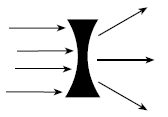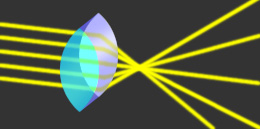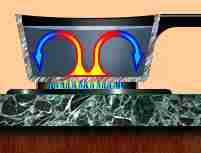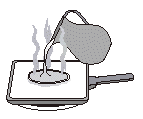Science 8- Benchmark III (23)
-
What is the "lowest temperature" in any matter which all "molecular motion" would stop?
-
Celcius scale
-
Fahrenheit scale
-
Kevin scale
-
Absolute zero
-

Final test to review for VA SOL test at end-of-year for 8th grade science. The student will review and prepare for objectives.
Quiz Preview
- 2.
What is the "building block" of all matter or the "smallest" particle of an element?
-
Compound
-
Molecule
-
Mixture
-
Atom
Correct Answer
A. AtomExplanation
An atom is the "building block" of all matter and the "smallest" particle of an element. It consists of a nucleus containing protons and neutrons, surrounded by electrons. Atoms combine to form molecules, compounds, and mixtures.Rate this question:
-
- 3.
What is a mirror curving "inward" or is rays are divergent (spreading out)?
-
Convex
-
Plane
-
Concave
-
Angle of incidence
Correct Answer
A. ConcaveExplanation
A mirror curving "inward" or where rays are divergent (spreading out) is called a concave mirror.Rate this question:
-
- 4.
What is a "possible answer" to a science question?
-
Data
-
Scienctific investigation
-
Hypothesis
-
Experiment
Correct Answer
A. HypothesisExplanation
A "possible answer" to a science question refers to a hypothesis. A hypothesis is an educated guess or a proposed explanation based on prior knowledge and observations. It is a statement that can be tested through scientific investigation and experiments. A hypothesis allows scientists to make predictions and design experiments to gather data and evidence to support or reject the hypothesis. Therefore, a hypothesis is considered a "possible answer" to a science question as it provides a starting point for further investigation and exploration.Rate this question:
-
- 5.
What is the "path" through which "electric current" can flow?
-
Current
-
Circuit
-
AC
-
DC
Correct Answer
A. CircuitExplanation
An electric current can flow through a circuit, which is a closed loop or pathway that allows the flow of electrons. A circuit typically consists of a power source, such as a battery or generator, conductive wires, and various components such as resistors, switches, and lights. When a circuit is complete and connected to a power source, the electric current can flow from the positive terminal of the source, through the circuit components, and back to the negative terminal, creating a continuous flow of electrons.Rate this question:
-
- 6.
What is the "mass" of a substance per unit of "volume"?
-
Volume
-
Density
-
Distance
-
Speed
Correct Answer
A. DensityExplanation
Density is the measure of mass per unit volume. It represents how much mass is present in a given volume of a substance. It is calculated by dividing the mass of the substance by its volume. Therefore, density is the correct answer to the question as it defines the relationship between mass and volume.Rate this question:
-
- 7.
What is the temperature scale on which water freezes at 0 degrees celcius and boils at 100 degrees celcius?
-
Fahrenheit scale
-
Celsius scale
-
Kelvin scale
-
Thermometer
Correct Answer
A. Celsius scaleExplanation
The correct answer is Celsius scale. The Celsius scale is a temperature scale where water freezes at 0 degrees Celsius and boils at 100 degrees Celsius. It is widely used in most parts of the world for everyday temperature measurements.Rate this question:
-
- 8.
What type of "change" results in the formation of one or more "new substances"?
-
Physical change
-
Chemical property
-
Chemical change
-
Change of state
Correct Answer
A. Chemical changeExplanation
A chemical change is a type of change that results in the formation of one or more new substances. In a chemical change, the original substances undergo a chemical reaction, leading to the formation of new substances with different properties. This is different from a physical change, where the substances may undergo a change in appearance or state but do not form new substances. A chemical change involves the breaking and forming of chemical bonds, resulting in a rearrangement of atoms and the creation of new substances.Rate this question:
-
- 9.
What is a mirror that has a "curving outward" shape or "convergent rays (coming to a point)?
-
Concave
-
Triangle
-
Plane
-
Convex
Correct Answer
A. ConvexExplanation
A convex mirror is a mirror that has a "curving outward" shape. It is also known for producing "convergent rays" that come to a point. Unlike concave mirrors, convex mirrors bulge outward and cause light rays to spread out, resulting in a wider field of view. This type of mirror is commonly used in security mirrors, car side-view mirrors, and some decorative mirrors.Rate this question:
-
- 10.
What is any substance that "releases hydrogen ions (H+)" in a solution and tastes "sour"?
-
Acid
-
Base
-
Neutral
-
Lemon
Correct Answer
A. AcidExplanation
An acid is a substance that releases hydrogen ions (H+) in a solution and tastes sour. It is characterized by its ability to donate protons or accept electrons. Acids can be found in various forms, such as hydrochloric acid (HCl) or acetic acid (CH3COOH), and they are commonly used in industries and laboratories for their corrosive properties.Rate this question:
-
- 11.
What does the "number of protons" in the atom's nucleus represent?
-
Top number
-
Atomic mass
-
Atomic number
-
Bottom number
Correct Answer
A. Atomic numberExplanation
The "number of protons" in the atom's nucleus represents the atomic number. The atomic number is a unique identifier for each element and determines its position on the periodic table. It indicates the number of protons in the nucleus, which also determines the element's chemical properties and its placement in the periodic table.Rate this question:
-
- 12.
What is any substance that releases "hydroxide ions (OH-)" in a solution and feels "slippery"?
-
Acid
-
Hydrogen
-
Base
-
Pond water
Correct Answer
A. BaseExplanation
A base is any substance that releases hydroxide ions (OH-) in a solution and feels slippery. Bases are the opposite of acids and have a pH greater than 7. They can neutralize acids and are commonly found in household products such as soaps, detergents, and antacids.Rate this question:
-
- 13.
What is a substance composed of "two or more elements" chemically joined in a "fixed proportion"?
-
Compound
-
Mixture
-
Suspension
-
Alloy
Correct Answer
A. CompoundExplanation
A compound is a substance that is made up of two or more elements that are chemically bonded together in a fixed proportion. In other words, the elements in a compound are combined in specific ratios and cannot be separated by physical means. This is different from a mixture, where the components are not chemically bonded and can be separated through physical processes. A suspension is a mixture in which solid particles are dispersed in a liquid or gas, and an alloy is a mixture of two or more metals.Rate this question:
-
- 14.
What is a "change of matter" from a "gas to a liquid"?
-
Condensation
-
Sublimation
-
Vaporization
-
Evaporation
Correct Answer
A. CondensationExplanation
Condensation is the correct answer because it refers to the process of a gas changing into a liquid state. This occurs when the gas loses heat energy and its particles slow down, coming together to form a liquid. This change of matter can be observed when water vapor in the air cools down and turns into liquid droplets, such as when dew forms on grass or when steam from a hot shower condenses on a mirror.Rate this question:
-
- 15.
What is a chemical equation in which each side of the equation has the same number of atoms of each element?
-
Chemical formula
-
Equation
-
Balanced equation
-
Chemical equation
Correct Answer
A. Balanced equationExplanation
A balanced equation is a chemical equation in which each side of the equation has the same number of atoms of each element. This means that the equation obeys the law of conservation of mass, as no atoms are created or destroyed during a chemical reaction. The coefficients in front of each compound or element are adjusted to ensure that the number of atoms on both sides of the equation are equal. A balanced equation is important in chemistry as it provides a clear representation of the reactants and products involved in a chemical reaction.Rate this question:
-
- 16.
What is the "rate of change" in "velocity"?
-
Speed
-
Acceleration
-
Force
-
Rate
Correct Answer
A. AccelerationExplanation
The rate of change in velocity is referred to as acceleration. Acceleration measures how quickly an object's velocity changes over time. It can be positive or negative, indicating whether the object is speeding up or slowing down. In other words, acceleration is the change in velocity divided by the change in time. Therefore, acceleration is the correct answer to the question.Rate this question:
-
- 17.
What is a "material" that allows "heat or electric charges" to flow through it easily?
-
Insulator
-
Conductor
-
Circuit
-
Current
Correct Answer
A. ConductorExplanation
A "conductor" is a material that allows heat or electric charges to flow through it easily. Unlike insulators, which impede the flow of heat or electric charges, conductors have a high conductivity and low resistance, making them efficient at transmitting heat or electricity. Circuits and currents are related to the flow of electricity, but they do not specifically refer to materials that allow the flow.Rate this question:
-
- 18.
Which scienctist's atomic model had "orbiting electrons" shifting postion from one fixed energy level to another and was "three-dimensional"?
-
Dalton
-
Rutherford
-
Bohr
-
Thompson
Correct Answer
A. BohrExplanation
Bohr's atomic model proposed that electrons orbit the nucleus in fixed energy levels or shells, and they can jump from one energy level to another by absorbing or emitting energy. This model also suggested that electrons move in three-dimensional paths around the nucleus, similar to planets orbiting the sun. This idea of quantized energy levels and the movement of electrons in specific orbits was a significant contribution to the understanding of atomic structure.Rate this question:
-
- 19.
What is the mass of one atom of an element which is "equal" to the number of "protons and neutrons" in the atom's nucleus?
-
Atomic number
-
Atomic mass
-
Equation
-
Symbol
Correct Answer
A. Atomic massExplanation
The atomic mass of an element represents the total mass of one atom of that element. It is equal to the sum of the number of protons and neutrons in the atom's nucleus. Therefore, the mass of one atom of an element that is "equal" to the number of protons and neutrons in the atom's nucleus is referred to as the atomic mass.Rate this question:
-
- 20.
What is the "transfer" of thermal energy by the "circulation" of a fluid? (Remember air (gas) and liquid is also considered a "fluid" in science).
-
Convection
-
Conduction
-
Insulator
-
Conductor
Correct Answer
A. ConvectionExplanation
Convection is the transfer of thermal energy through the circulation of a fluid, whether it is a gas like air or a liquid. In convection, heat is transferred through the movement of the fluid itself, as warmer fluid rises and cooler fluid sinks, creating a continuous circulation. This circulation allows for the transfer of heat from one location to another. Conduction, on the other hand, is the transfer of heat through direct contact between objects, while insulators prevent the transfer of heat and conductors facilitate it.Rate this question:
-
- 21.
What is a "shorthand description" of a chemical reaction, using symbols, number, and formulas?
-
Chemical formula
-
Chemical equation
-
Chemical change
-
Chemical property
Correct Answer
A. Chemical equationExplanation
A "shorthand description" of a chemical reaction, using symbols, numbers, and formulas, is referred to as a chemical equation. This equation represents the reactants and products involved in the reaction, providing a concise way to convey the essential information about the chemical reaction. It helps to understand the types and quantities of substances involved and the changes that occur during the reaction.Rate this question:
-
- 22.
What is an interpretation based on research, experience, and data?
-
Hypothesis
-
Observation
-
Conclusion
-
Data
Correct Answer
A. ConclusionExplanation
A conclusion is an interpretation that is based on research, experience, and data. It is a statement or judgment that is made after analyzing and evaluating the available information. A conclusion is drawn when all the evidence and facts have been considered, and it represents the final outcome or result of a study or investigation. It is a logical inference that is supported by evidence and is often used to summarize the findings or implications of a research study. Therefore, a conclusion is the most appropriate choice among the given options.Rate this question:
-
- 23.
What is the transfer of "thermal energy" from particle to particle through "direct" contact?
-
Convection
-
Combustibility
-
Diffraction
-
Conduction
Correct Answer
A. ConductionExplanation
Conduction is the transfer of thermal energy from particle to particle through direct contact. This means that heat is transferred when particles collide with each other and transfer energy. Convection, on the other hand, is the transfer of heat through the movement of fluids, while diffraction refers to the bending of waves around obstacles. Combustibility is unrelated to the transfer of thermal energy.Rate this question:
-
- 24.
What is the distance from the "midpoint of a wave" to a "crest or trough"?
-
Wavelength
-
Crest
-
Amplitude
-
Trough
Correct Answer
A. AmplitudeExplanation
The distance from the "midpoint of a wave" to a "crest or trough" is referred to as the amplitude. Amplitude represents the maximum displacement of a wave from its equilibrium position. It is a measure of the wave's intensity or energy.Rate this question:
-
Quiz Review Timeline (Updated): Mar 17, 2023 +
Our quizzes are rigorously reviewed, monitored and continuously updated by our expert board to maintain accuracy, relevance, and timeliness.
-
Current Version
-
Mar 17, 2023Quiz Edited by
ProProfs Editorial Team -
Apr 26, 2009Quiz Created by
Pcooper
 Back to top
Back to top






